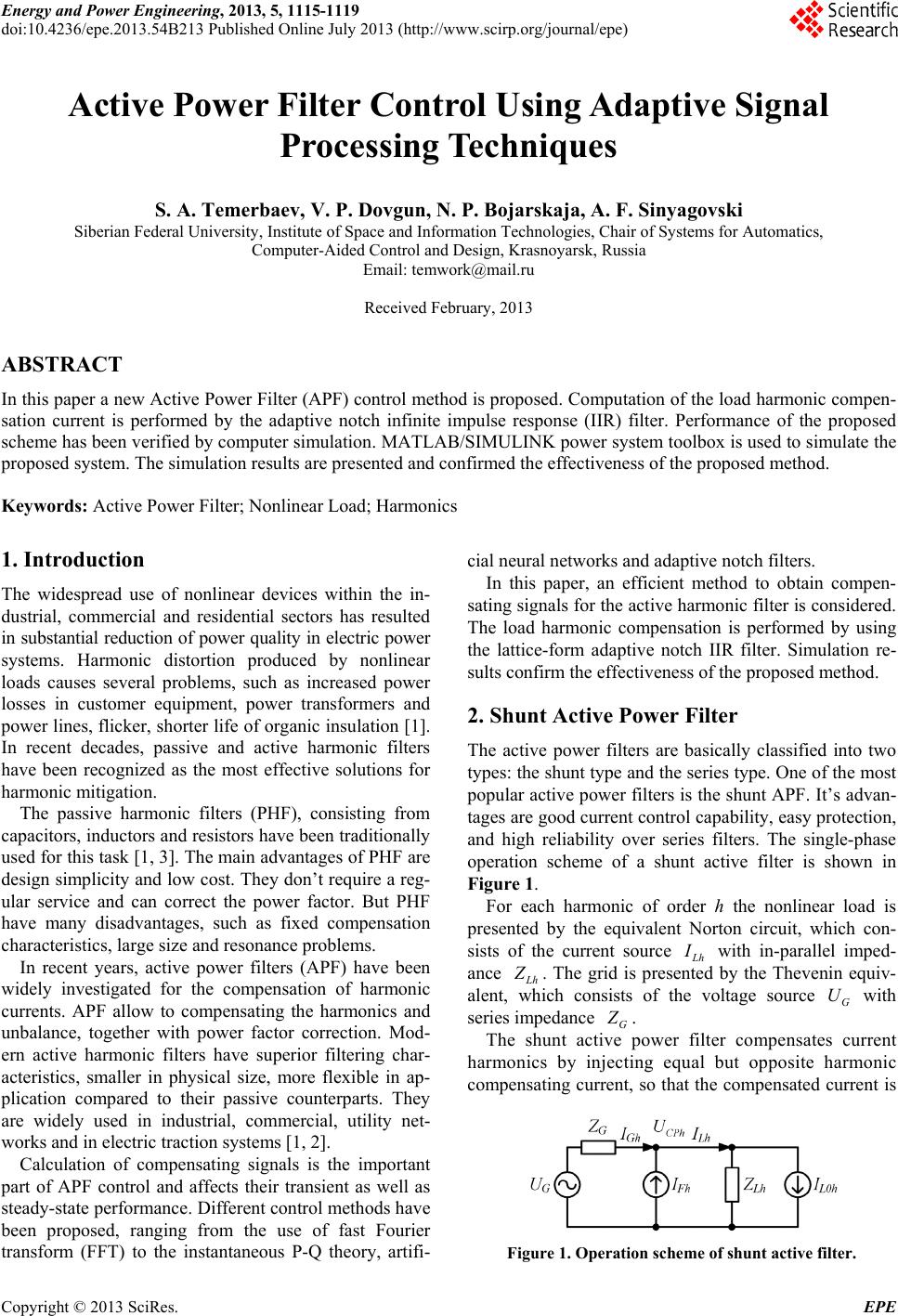
Energy and Power Engineering, 2013, 5, 1115-1119
doi:10.4236/epe.2013.54B213 Published Online July 2013 (http://www.scirp.org/journal/epe)
Active Power Filter Control Using Adaptive Signal
Pr ocessing Techniques
S. A. Temerbaev, V. P. Dovgun, N. P. Bojarskaja, A. F. Sinyagovski
Siberian Federal University, Institute of Space and Information Technologies, Chair of Systems for Automatics,
Computer-Aided Control and Design, Krasnoyarsk, Russia
Email: temwork@mail.ru
Received February, 2013
ABSTRACT
In this paper a new Active Power Filter (APF) control method is proposed . Computation of the load harmonic compen-
sation current is performed by the adaptive notch infinite impulse response (IIR) filter. Performance of the proposed
scheme has been verified by computer simulation. MATLAB/SIMULINK power system toolbox is used to simulate the
proposed system. The simulation results are presented and confirmed the effectiveness of the proposed method.
Keywords: Active Power Filter; Nonlinear Load; Harmonics
1. Introduction
The widespread use of nonlinear devices within the in-
dustrial, commercial and residential sectors has resulted
in substantial reduction of power quality in electric power
systems. Harmonic distortion produced by nonlinear
loads causes several problems, such as increased power
losses in customer equipment, power transformers and
power lines, flicker, shorter life of organic insulation [1].
In recent decades, passive and active harmonic filters
have been recognized as the most effective solutions for
harmonic mitigation.
The passive harmonic filters (PHF), consisting from
capacitors, inductors and resistors have been trad itionally
used for this task [1, 3]. The main advantages of PHF are
design simplicity and low cost. Th ey don’t require a reg-
ular service and can correct the power factor. But PHF
have many disadvantages, such as fixed compensation
characteristics, large size and resonance problems.
In recent years, active power filters (APF) have been
widely investigated for the compensation of harmonic
currents. APF allow to compensating the harmonics and
unbalance, together with power factor correction. Mod-
ern active harmonic filters have superior filtering char-
acteristics, smaller in physical size, more flexible in ap-
plication compared to their passive counterparts. They
are widely used in industrial, commercial, utility net-
works and in electric traction systems [1, 2].
Calculation of compensating signals is the important
part of APF control and affects their transient as well as
steady-state performance. Different control methods have
been proposed, ranging from the use of fast Fourier
transform (FFT) to the instantaneous P-Q theory, artifi-
cial neural networks and adaptive notch filters.
In this paper, an efficient method to obtain compen-
sating signals for the active harmonic filter is considered.
The load harmonic compensation is performed by using
the lattice-form adaptive notch IIR filter. Simulation re-
sults confirm the effectiveness of the proposed method.
2. Shunt Active Power Filter
The active power filters are basically classified into two
types: the shunt type and the series type. One of the most
popular active power filters is the shun t APF. It’s advan-
tages are good current con trol capability, easy p rotection,
and high reliability over series filters. The single-phase
operation scheme of a shunt active filter is shown in
Figure 1.
For each harmonic of order h the nonlinear load is
presented by the equivalent Norton circuit, which con-
sists of the current source
h
with in-parallel imped-
ance
h
. The grid is presented by the Thevenin equiv-
alent, which consists of the voltage source with
series impedance G
U
G
.
The shunt active power filter compensates current
harmonics by injecting equal but opposite harmonic
compensating current, so that the compensated current is
Figure 1. Operation scheme of shunt active filter.
Copyright © 2013 SciRes. EPE